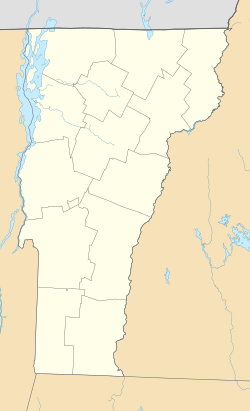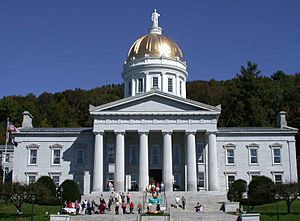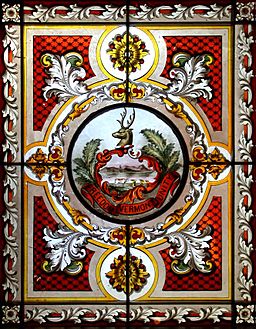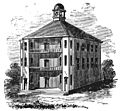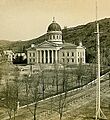Vermont State House facts for kids
|
Vermont State House
|
|
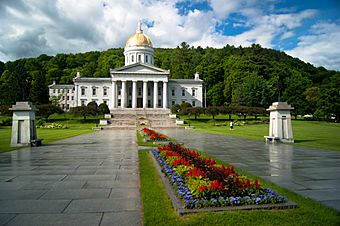
The State House in June 2012
|
|
| Location | Montpelier, Vermont, U.S. |
|---|---|
| Built | 1833 |
| Architect | Ammi Burnham Young Thomas Silloway |
| Architectural style | Greek Revival |
| NRHP reference No. | 70000739 |
Quick facts for kids Significant dates |
|
| Added to NRHP | December 30, 1970 |
| Designated NHL | December 30, 1970 |
The Vermont State House is in Montpelier, Vermont. It is the main building for the government of Vermont. This building is where the Vermont General Assembly meets. It is the third building used as the State House on this spot. The current building was designed by Thomas Silloway in 1857 and 1858. It opened in 1859.
The Vermont State House looks like Neoclassical and Greek Revival buildings. Its inside has styles like American Empire and Renaissance Revival. A big project to fix up the State House started in the 1980s. This project helped bring back its original look.
The Vermont State House is on State Street in Montpelier. It sits near a wooded hill. Its special gold leaf dome is easy to see from far away. Montpelier is the smallest city that is a capital in the U.S.
Contents
History of the State House
Building Design and Changes
The building you see today was designed by architect Thomas Silloway. He used ideas from an older building by Ammi B. Young. The first State House was built in 1808. It was later replaced by a new building.
The second State House was built from 1833 to 1838. It was also on the same spot. Young's design was simpler, like an ancient Greek temple. It was made of gray Barre granite. It had a front porch with Doric columns. A low, round dome was on top.
A fire in January 1857 almost destroyed Young's building. Silloway saved the front porch and some granite walls. He made the building wider. He also made the dome much taller. This new dome was made of copper over wood. It might have been made taller to look like the new Capitol dome in Washington, D.C.
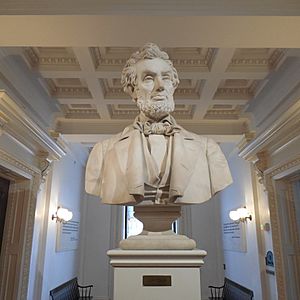
The dome and roofs were first painted a dark red. They looked like old Italian tiles. The dome was not gold until the early 1900s. Many states added gold domes around that time. A statue named Agriculture sits on top of the dome. It shows Ceres, an ancient Roman goddess of farming.
The first statue was made by Vermont artist Larkin Goldsmith Mead in 1858. When it got old, a new one was carved in 1938. This new statue was made by Dwight Dwinell. In 2018, that statue was removed. The current statue was carved by Chris Miller. It is made of mahogany wood.
The front porch has a granite statue of Ethan Allen. He helped start Vermont. He also led a group called the Green Mountain Boys. This group was active when Vermont was its own republic. The statue was made in 1941 by Aristide Piccini. It replaced an older marble one by Larkin Goldsmith Mead.
Inside the State House
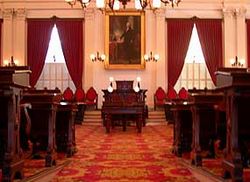
The State House has two main floors. You can use circular stairs or an elevator to go between them. The entrance hall has portraits of Presidents Calvin Coolidge and Chester A. Arthur. Both were from Vermont. The front doors were painted to look like bronze. A portrait of Admiral George Dewey is also in the entrance.
The State House does not have a large open space under the dome, called a rotunda. The dome is right above the Representatives Hall. A main public room is the Hall of Inscriptions. It has eight large marble tablets. These tablets have quotes about Vermont's history and culture. They quote people like Ethan Allen and Calvin Coolidge. Each tablet has fourteen gold stars. These stars show Vermont's fourteen counties. They also show that Vermont was the fourteenth state to join the U.S.
The office for the Governor of Vermont is on the second floor. It is used for meetings and signing laws. This office looks like it did in 1859. It has fancy windows and gold decorations. The carpet was specially made to match the old design. The Governor's main office is at a nearby building called The Pavilion.
Portraits of Vermont governors are on display throughout the State House. These include Howard Dean, shown in a canoe. The hallways are like a gallery of famous Vermonters.
The two rooms for the Vermont General Assembly are on the second floor. Visitors can sit quietly in these rooms. The Vermont Senate room uses green and gold colors. The Vermont House of Representatives room uses red and gold. A large light fixture hangs in the Representatives Hall. It has sculptures of old figures.
The Cedar Creek Room is a large room on the second floor. It has a big painting by Julian Scott from 1874. The painting shows the Battle of Cedar Creek from the American Civil War. It highlights Vermont soldiers in the battle. Two stained glass skylights light up the room. They were found broken in the attic and put back together.
One skylight shows the coat of arms of Vermont. It has a white-tailed deer head and Eastern White Pine branches. Pine branches were a symbol for Vermont citizens. The other skylight shows a female figure called "Vermontannia." She represents the state. The walls in this room have original patterns. They are painted in many colors.
Most of the furniture in the building is from 1859. This includes 30 black walnut chairs in the Senate chamber. Many of the lights are also original. They were gas lights but are now electric. A large portrait of George Washington survived the 1857 fire. It hangs in the Representatives Hall.
Visiting the Vermont State House
The Vermont State House is sometimes called "the People's House." This is because it is very open to visitors. It is used for government work and as a museum.
The building is open to everyone. You can visit whether the lawmakers are meeting or not. The Representatives Hall hosts evening concerts in winter. The lawn outside is used for concerts and other events in warmer weather. People also sit, eat, and play sports there. Art by local citizens is often displayed in the hallways.
Every February 14, red paper hearts appear on the building's columns. This is done by someone called the Valentine Phantom. The lawn and steps are also used for peaceful protests and press conferences.
In 2013, Google added the Vermont State House to its Street View.
Images for kids
See also
 In Spanish: Casa del Estado de Vermont para niños
In Spanish: Casa del Estado de Vermont para niños


